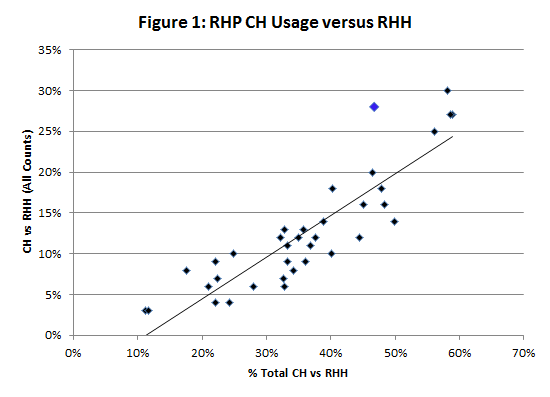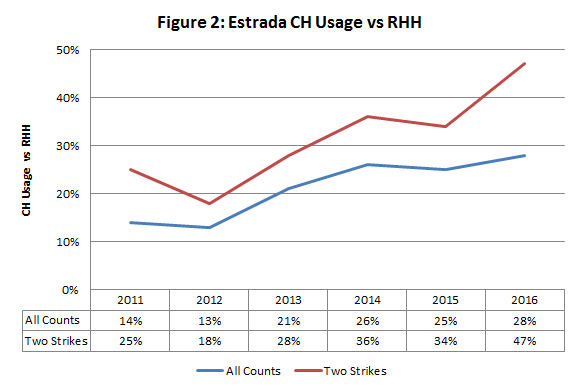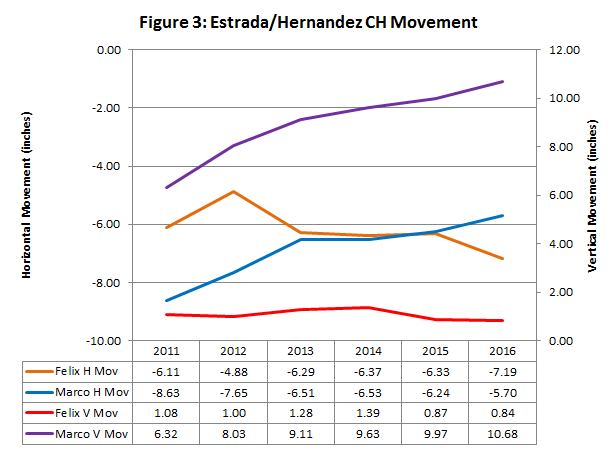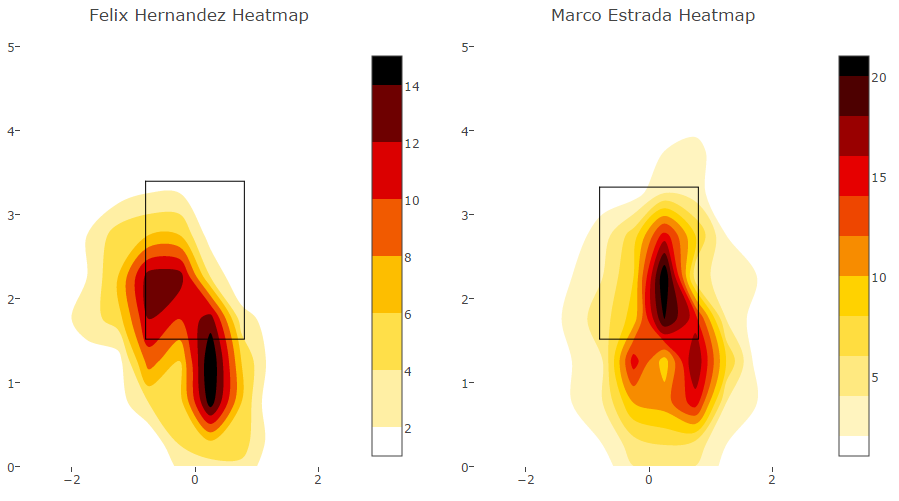The changeup can be a devastating pitch with its doppelganger-like deception; and the Blue Jays’ Marco Estrada just so happens to feature one of the finest in all of baseball. Estrada’s style is the antithesis of baseball’s modern era, where a hurler’s panache is measured by how hard he can throw. When Marco entered the league back in 2008, the average fastball velocity was just under 91 miles per hour. Eight short years later that figure has climbed to 92.5. As well, eight starting pitchers are currently throwing their slider harder than the 88.97 miles per hour Estrada averages with his four seam fastball, and another seven are within a stone’s throw. In an age where maximum effort and closer-like mentalities reign supreme, Marco Estrada emits an aura of elegance on the mound, with each batter acting as a canvas for his artistic genius.
Baseball is a game of traditions, unwritten rules, and superstitions; and for decades the idea of throwing a changeup to a same sided batter ran contrary to all three. By its very nature the changeup is designed to mimic the fastball at a lesser pace, which results in fading action towards the arm side. This makes it an excellent weapon versus the opposite handedness – a pitch down and moving away from the swing plane is near impossible to make firm contact against – but physics dictate that against a same sided batter it will fade down and in to an area which hitters have absolutely mashed. In an excellent piece written by Ben Lindbergh for Baseball Prospectus back in 2013, Lindbergh noted that over a six year sample from 2008 to mid-2013, changeups thrown to same sided batters accounted for between just 21 and 26 percent of the total changeups. By those measures, 74 to 79 percent of changeups were thrown in the “traditional” sense – right on left, or left on right.
As he’s wont to do, Marco Estrada has continued to march against the tides of archaic customs and has taken the “Danks Theory” developed by the Tampa Bay Rays in the first half of the decade to the extreme. According to Lindbergh’s research, as a team the Rays set the pace for baseball with 34.1 percent of changeups thrown to same sided batters from 2011 to mid-2013, when the league average was just a hair above 22 percent. Through 20 starts in 2016, Estrada has thrown 46.7 percent of his changeups to right handed batters, which is the eighth highest mark among 36 right handed starters to have thrown 200 changeups. Eighth doesn’t sound like a noteworthy placement, but as Figure 1 below shows, it’s weighed down by the fact that Estrada throws a ton of changeups to left handers too. When plotting the relative percentage of changeups thrown to right handed batters versus the changeup usage among all pitches versus right handed batters, Estrada (indicated in blue) is the furthest from the trend line between the two variables and stands on an island by himself.
In all counts this season, right handed batters have seen a changeup from Estrada 28 percent of the time, the second highest mark in baseball behind one Felix Hernandez (30 percent). This continues an upward trend dating back to Estrada’s first concrete opportunity at the big leagues in 2011. Figure 2 below displays his year-by-year all counts changeup usage versus right handed batters, as well as his even more pronounced growth in usage with two strikes where his 2016 rate of 46 percent again ranks second only to The King (53 percent).
What Estrada and Hernandez are attempting runs completely against conventional wisdom, and remarkably, they couldn’t be achieving their success through more conflicting techniques. Over the past six years, Felix has coaxed more and more horizontal run (orange) while almost entirely eliminating the fluttering aspect of the changeup, causing the pitch to sink at a rate approaching that of an entirely spinless pitch (red). Marco has done the complete reverse; fully exploiting his overhead delivery by steadily decreasing the arm-side run (blue) and inflating the relative vertical movement (purple).
Understandably, the two right handers have developed and tailored their changeups to best imitate their own respective fastballs, and this is easily observed with the calculated spin axis. The movement on Hernandez’ sinker rotates around an axis of 241 degrees, and his changeup closely follows suit with an axis of 279 degrees. Steadily approaching perfect backspin, Estrada throws his four seam fastball with spin axis of 188 degrees, with the spin axis of his changeup being calculated at 211 degrees.
Against right handed batters, Hernandez has countered the worrisome down-and-in stigma by throwing the changeup so hard and with so much multi-plane movement that even if it does break into their swing plane, the hitter can do little more than drive the ball into the ground; his 69 percent groundball rate with the changeup ranks fifth among 120 starting pitchers to throw at least 100 of them this season. Because it has so much sink and is incredibly difficult to get under, Hernandez is sporting a comical infield fly ball rate of 0.0 percent in 2016 – though it had hovered around a respectable 17 and 18 percent the previous three seasons.
Estrada generates groundballs at a considerably more modest rate – just 42 percent, ranking 93rd – but he more than makes up for it by inducing an almost unfathomable volume of pop-ups. His infield fly ball rate this season is sitting at 46.2 percent (just under half of the fly balls he surrenders on his changeup don’t escape the infield), and while that would represent a career best, he had maintained a pop-up rate exceeding 30 percent in three of his previous four seasons.
Where Hernandez buries his changeup far down and away from right handers – and even runs it in on the hands like a two seam fastball – it’s essential that Estrada focuses on keeping the changeup on the outer half. By keeping it away he forces the right handed batters out onto their front foot with an unbalanced swing; too close to the inner half and the 80 mile per hour butterfly of a changeup is just asking to be pulled into left field with authority. Below, via MLB Savant, are the 2016 changeup-versus-righties heat maps for Hernandez (left) and Estrada (right).
Baseball is a traditional sport, but for those willing to push the boundaries of conventional lore there is the potential for unforeseen strengths where only weaknesses were anticipated. The right-on-right changeup isn’t nearly as exotic and old-man-yelling-at-cloud prompting as valuing on-base percentage over batting average or shifting your defenders to the most advantageous fielding positions, but it was still yet another barrier that most were unwilling to cross until just recently and it has already proven to be an incredible asset to those bold enough to take the plunge. The Marco Estrada’s career doesn’t have a whole lot in common with that of the illustrious Felix Hernandez, but when it comes to retiring batters with the unusual right-on-right changeup approach, the Blue Jays would-be ace has a place among royalty.
All data via Brooks Baseball unless otherwise noted; up to date as of August 11th.
Lead Photo: Nick Turchiaro-USA TODAY Sports




